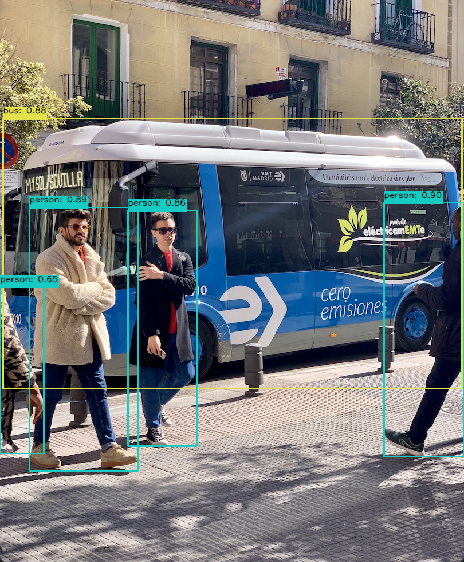YOLOv8 目标检测程序,依赖的库最少,使用onnxruntime推理
flyfish
为了方便理解,加入了注释
py
"""
YOLOv8 目标检测程序
Author: flyfish
Date:
Description: 该程序使用ONNX运行时进行YOLOv8模型的目标检测。
它对输入图像进行预处理,运行推理,并对输出进行后处理,在图像上绘制边界框和标签。
"""
import argparse
import cv2
import numpy as np
import onnxruntime as ort
# 定义类别字典,将类别ID映射到类别名称
classes = {
0: 'person', 1: 'bicycle', 2: 'car', 3: 'motorcycle', 4: 'airplane', 5: 'bus', 6: 'train', 7: 'truck', 8: 'boat',
9: 'traffic light', 10: 'fire hydrant', 11: 'stop sign', 12: 'parking meter', 13: 'bench', 14: 'bird', 15: 'cat',
16: 'dog', 17: 'horse', 18: 'sheep', 19: 'cow', 20: 'elephant', 21: 'bear', 22: 'zebra', 23: 'giraffe',
24: 'backpack', 25: 'umbrella', 26: 'handbag', 27: 'tie', 28: 'suitcase', 29: 'frisbee', 30: 'skis',
31: 'snowboard', 32: 'sports ball', 33: 'kite', 34: 'baseball bat', 35: 'baseball glove', 36: 'skateboard',
37: 'surfboard', 38: 'tennis racket', 39: 'bottle', 40: 'wine glass', 41: 'cup', 42: 'fork', 43: 'knife',
44: 'spoon', 45: 'bowl', 46: 'banana', 47: 'apple', 48: 'sandwich', 49: 'orange', 50: 'broccoli', 51: 'carrot',
52: 'hot dog', 53: 'pizza', 54: 'donut', 55: 'cake', 56: 'chair', 57: 'couch', 58: 'potted plant', 59: 'bed',
60: 'dining table', 61: 'toilet', 62: 'tv', 63: 'laptop', 64: 'mouse', 65: 'remote', 66: 'keyboard',
67: 'cell phone', 68: 'microwave', 69: 'oven', 70: 'toaster', 71: 'sink', 72: 'refrigerator', 73: 'book',
74: 'clock', 75: 'vase', 76: 'scissors', 77: 'teddy bear', 78: 'hair drier', 79: 'toothbrush'
}
class YOLOv8:
"""YOLOv8目标检测模型类,用于处理推理和可视化。"""
def __init__(self, onnx_model, input_image, confidence_thres, iou_thres):
"""
初始化YOLOv8类的实例。
参数:
onnx_model: ONNX模型的路径。
input_image: 输入图像的路径。
confidence_thres: 用于过滤检测结果的置信度阈值。
iou_thres: 非极大值抑制的IoU(交并比)阈值。
"""
self.onnx_model = onnx_model
self.input_image = input_image
self.confidence_thres = confidence_thres
self.iou_thres = iou_thres
# 加载类别名称
self.classes = classes
# 为每个类别生成一个颜色调色板
self.color_palette = np.random.uniform(0, 255, size=(len(self.classes), 3))
def draw_detections(self, img, box, score, class_id):
"""
在输入图像上绘制检测到的边界框和标签。
参数:
img: 要在其上绘制检测结果的输入图像。
box: 检测到的边界框。
score: 对应的检测置信度分数。
class_id: 检测到的对象的类别ID。
返回值:
无
"""
# 提取边界框的坐标
x1, y1, w, h = box
# 获取类别ID对应的颜色
color = self.color_palette[class_id]
# 在图像上绘制边界框
cv2.rectangle(img, (int(x1), int(y1)), (int(x1 + w), int(y1 + h)), color, 2)
# 创建包含类别名称和置信度分数的标签文本
label = f"{self.classes[class_id]}: {score:.2f}"
# 计算标签文本的尺寸
(label_width, label_height), _ = cv2.getTextSize(label, cv2.FONT_HERSHEY_SIMPLEX, 0.5, 1)
# 计算标签文本的位置
label_x = x1
label_y = y1 - 10 if y1 - 10 > label_height else y1 + 10
# 绘制填充矩形作为标签文本的背景
cv2.rectangle(
img, (label_x, label_y - label_height), (label_x + label_width, label_y + label_height), color, cv2.FILLED
)
# 在图像上绘制标签文本
cv2.putText(img, label, (label_x, label_y), cv2.FONT_HERSHEY_SIMPLEX, 0.5, (0, 0, 0), 1, cv2.LINE_AA)
def preprocess(self):
"""
在执行推理之前预处理输入图像。
返回值:
image_data: 预处理后的图像数据,准备进行推理。
"""
# 使用OpenCV读取输入图像
self.img = cv2.imread(self.input_image)
# 获取输入图像的高度和宽度
self.img_height, self.img_width = self.img.shape[:2]
# 将图像的颜色空间从BGR转换为RGB
img = cv2.cvtColor(self.img, cv2.COLOR_BGR2RGB)
# 调整图像大小以匹配输入形状
img = cv2.resize(img, (self.input_width, self.input_height))
# 通过除以255.0来规范化图像数据
image_data = np.array(img) / 255.0
# 转置图像,使通道维度为第一个维度
image_data = np.transpose(image_data, (2, 0, 1)) # 通道优先
# 扩展图像数据的维度以匹配预期的输入形状
image_data = np.expand_dims(image_data, axis=0).astype(np.float32)
# 返回预处理后的图像数据
return image_data
def postprocess(self, input_image, output):
"""
对模型的输出进行后处理,以提取边界框、置信度分数和类别ID。
参数:
input_image (numpy.ndarray): 输入图像。
output (numpy.ndarray): 模型的输出。
返回值:
numpy.ndarray: 带有绘制检测结果的输入图像。
"""
# 转置并压缩输出以匹配预期的形状
outputs = np.transpose(np.squeeze(output[0]))
# 获取输出数组中的行数
rows = outputs.shape[0]
# 用于存储检测到的边界框、置信度分数和类别ID的列表
boxes = []
scores = []
class_ids = []
# 计算边界框坐标的缩放因子
x_factor = self.img_width / self.input_width
y_factor = self.img_height / self.input_height
# 遍历输出数组中的每一行
for i in range(rows):
# 从当前行中提取类别分数
classes_scores = outputs[i][4:]
# 找到类别分数中的最大值
max_score = np.amax(classes_scores)
# 如果最大值大于置信度阈值
if max_score >= self.confidence_thres:
# 获取具有最高分数的类别ID
class_id = np.argmax(classes_scores)
# 从当前行中提取边界框坐标
x, y, w, h = outputs[i][0], outputs[i][1], outputs[i][2], outputs[i][3]
# 计算缩放后的边界框坐标
left = int((x - w / 2) * x_factor)
top = int((y - h / 2) * y_factor)
width = int(w * x_factor)
height = int(h * y_factor)
# 将类别ID、置信度分数和边界框坐标添加到各自的列表中
class_ids.append(class_id)
scores.append(max_score)
boxes.append([left, top, width, height])
# 应用非极大值抑制以过滤重叠的边界框
indices = cv2.dnn.NMSBoxes(boxes, scores, self.confidence_thres, self.iou_thres)
# 遍历非极大值抑制后选择的索引
for i in indices:
# 获取对应于索引的边界框、置信度分数和类别ID
box = boxes[i]
score = scores[i]
class_id = class_ids[i]
# 在输入图像上绘制检测结果
self.draw_detections(input_image, box, score, class_id)
# 返回修改后的输入图像
return input_image
def main(self):
"""
使用ONNX模型执行推理并返回带有绘制检测结果的输出图像。
返回值:
output_img: 带有绘制检测结果的输出图像。
"""
# 使用ONNX模型创建推理会话并指定执行提供程序
session = ort.InferenceSession(self.onnx_model, providers=["CUDAExecutionProvider", "CPUExecutionProvider"])
# 获取模型输入
model_inputs = session.get_inputs()
# 存储输入的形状以便稍后使用
input_shape = model_inputs[0].shape
self.input_width = input_shape[2]
self.input_height = input_shape[3]
# 预处理图像数据
img_data = self.preprocess()
# 使用预处理后的图像数据进行推理
outputs = session.run(None, {model_inputs[0].name: img_data})
# 对输出进行后处理以获得输出图像
return self.postprocess(self.img, outputs) # 输出图像
if __name__ == "__main__":
# 创建一个参数解析器以处理命令行参数
parser = argparse.ArgumentParser()
parser.add_argument("--model", type=str, default="yolov8n.onnx", help="输入您的ONNX模型。")
parser.add_argument("--img", type=str, default="bus.jpg", help="输入图像的路径。")
parser.add_argument("--conf-thres", type=float, default=0.5, help="置信度阈值")
parser.add_argument("--iou-thres", type=float, default=0.5, help="非极大值抑制的IoU阈值")
args = parser.parse_args()
# 使用指定的参数创建YOLOv8类的实例
detection = YOLOv8(args.model, args.img, args.conf_thres, args.iou_thres)
# 执行目标检测并获取输出图像
output_image = detection.main()
# 在窗口中显示输出图像
cv2.namedWindow("Output", cv2.WINDOW_NORMAL)
cv2.imshow("Output", output_image)
# 等待按键以退出
cv2.waitKey(0)